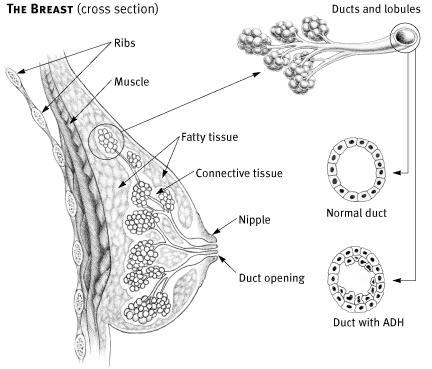If you've been diagnosed with ADH, you'll need expert advice on the treatment and follow-up that's best for you. The following general information may not cover your situation exactly.
What's atypical ductal hyperplasia (ADH)?
It's the name given to a condition that can occur in the lining of the milk ducts in the breast. Normally each duct is lined with an even layer of cells, but in the area affected by ADH there can be many layers. However, this change is not cancerous, and ADH is not a form of breast cancer.
The illustrations below show a normal duct and a duct that's developed extra cells. This extra growth is called hyperplasia. If the cells look unusual in size or shape, as they do in the illustration, the hyperplasia is called atypical. Despite this unusual appearance, the extra cells in atypical ductal hyperplasia are still dividing in a controlled way. These cells are not cancerous.

Diagnosing atypical ductal hyperplasia
You may have been diagnosed with ADH after having a routine mammogram. On a mammogram, ADH can appear as a particular pattern of tiny calcifications. While calcification is often of no significance, it can occur in clusters that require further investigation. Usually a core needle biopsy will be suggested. Under local anaesthetic, the doctor removes a sliver of tissue and then sends this to a pathologist. The diagnosis may also be made by surgical (open) biopsy. A surgical biopsy is done in a hospital, but usually you won't have to stay overnight.
Alternatively, you may be diagnosed with ADH after you've noticed a breast problem of some kind. For example, your doctor may decide that a lump needs to be investigated. A mammogram and/or ultrasound is often the first step, followed by a core needle biopsy. Some of the cells removed may then reveal ADH. However, it's not ADH that you were feeling in the lump — this is likely to be just fibrous tissue. ADH doesn't normally cause changes that can be felt. In this sense it is an 'accidental' finding.
Follow-up
In most women ADH is harmless and won't cause any problems in the future. However, in a few women with ADH, breast cancer can occur at a later date in the same breast or in the other one. Learning about this risk can raise anxiety in women newly diagnosed with ADH, but the risk is small. With regular follow-up, any breast cancer that does develop is likely to be found early.
For some women, it's recommended to remove an area of ADH to make sure it's the only abnormality present at the time.
The follow-up usually advised for women with ADH is an annual mammogram and a physical breast examination by a doctor. Your doctor may also want to check that you're aware of the best way to examine your own breasts for signs of unusual change.
Some women are diagnosed with ADH after having a screening mammogram through the BreastScreen program, and wish to remain in the program. This is usually possible, but yearly screening mammograms will be recommended rather than every 2 years as usually recommended.
Hormone replacement therapy
Women with a diagnosis of atypical ductal hyperplasia may think about taking hormone replacement therapy (HRT) if they're troubled by symptoms arising from menopause. Although the risks are unclear, the benefits of HRT can be important for individual women. If you're considering taking HRT, discuss your situation with your doctor. In particular, ask about the appropriate dosage, the length of time to continue taking HRT, and any other preparations that may help with problems arising from menopause.
You can also ring Cancer Council on 13 11 20 to discuss questions of concern to you.